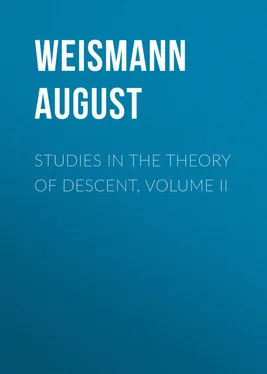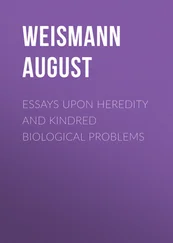August Weismann - Studies in the Theory of Descent, Volume II
Здесь есть возможность читать онлайн «August Weismann - Studies in the Theory of Descent, Volume II» — ознакомительный отрывок электронной книги совершенно бесплатно, а после прочтения отрывка купить полную версию. В некоторых случаях можно слушать аудио, скачать через торрент в формате fb2 и присутствует краткое содержание. Жанр: foreign_antique, foreign_prose, на английском языке. Описание произведения, (предисловие) а так же отзывы посетителей доступны на портале библиотеки ЛибКат.
- Название:Studies in the Theory of Descent, Volume II
- Автор:
- Жанр:
- Год:неизвестен
- ISBN:нет данных
- Рейтинг книги:4 / 5. Голосов: 1
-
Избранное:Добавить в избранное
- Отзывы:
-
Ваша оценка:
- 80
- 1
- 2
- 3
- 4
- 5
Studies in the Theory of Descent, Volume II: краткое содержание, описание и аннотация
Предлагаем к чтению аннотацию, описание, краткое содержание или предисловие (зависит от того, что написал сам автор книги «Studies in the Theory of Descent, Volume II»). Если вы не нашли необходимую информацию о книге — напишите в комментариях, мы постараемся отыскать её.
Studies in the Theory of Descent, Volume II — читать онлайн ознакомительный отрывок
Ниже представлен текст книги, разбитый по страницам. Система сохранения места последней прочитанной страницы, позволяет с удобством читать онлайн бесплатно книгу «Studies in the Theory of Descent, Volume II», без необходимости каждый раз заново искать на чём Вы остановились. Поставьте закладку, и сможете в любой момент перейти на страницу, на которой закончили чтение.
Интервал:
Закладка:
Now this strained explanation is eminently inapplicable to varieties, still less to species, and least of all to higher systematic groups, for the simple reason that every wave of transformation may be assumed to be at the most of such strength as to produce a deviation of form equal to that of a variety. Were the change resulting from a single disturbance greater, we should not only find one-sided varieties, i. e. those belonging to one stage, but we should also meet as frequently with one-sided species. If, however, a wave of transformation can only produce a variety even in the case of greatest form-divergence, the above hypothetical uncontemporaneous action of such a wave in two species could only give rise to such small differences in the two stages that we could but designate them as varieties. An accumulation of the results of the action of several successive waves passing over the same species could not happen, because the distance from a neighbouring species would always become the same in two stages as soon as one wave had ended its course. In this manner there could therefore only arise divergences of the value of varieties, and incongruences in systematic groups of a higher rank could not thus be explained.
All explanations of the second form of incongruence from the point of view of a phyletic force can also be shown to be absurd. How can the fact be explained that larval and imaginal families by no means always coincide; or that the larvæ can only be formed into families whilst the imagines partly form sharply defined groups of a higher order? How can an internal directive force within the same organism urge in two quite distinct directions? If the evolution of a definite system were designed, and the admission of such a continually acting power rendered necessary, why such an incomplete, uncertain, and confused performance?
I must leave others to answer these questions; to me a vital force appears to be inadmissible, not only because we cannot understand the phenomena by its aid, but above all because it is superfluous for their explanation. In accordance with general principles the assumption of an unknown force can, however, only be made when it is indispensable to the comprehension of the phenomena.
I believe that the phenomena can be quite well understood without any such assumption – both the phenomena of congruence and incongruence, in their two forms of unequal divergence and unequal group-formation.
Let us in the first place admit that there is no directive force in the organism inciting periodic change, but that every change is always the consequence of external conditions, being ultimately nothing but the reaction – the response of the organism to some of the influences proceeding from the environment; every living form would in this case remain constant so long as it was not compelled to change by inciting causes. Such transforming factors can act directly or indirectly, i. e. they can produce new changes immediately, or can bring about a remodelling by the combination, accumulation, or suppression of individual variations already present (adaptation by natural selection). Both forms of this action of external influences have long been shown to be in actual operation, so that no new assumption will be made, but only an attempt to explain the phenomena in question by the sole action of these known factors of species formation.
If, in the first instance, we fix our attention upon that form of incongruence which manifests itself through unequal divergence of form-relationship, it will appear prominently that this bears precise relations to the different systematic groups. This form of incongruence constitutes the rule in varieties of the order Lepidoptera, it is of very frequent occurrence in species, but disappears almost completely in genera, and entirely in the case of families and the higher groups. On the whole, therefore, as we turn to more and more comprehensive groups, the incongruence diminishes whilst the congruence increases, until finally the latter becomes the rule.
Now if congruence presupposes an equal number of transforming impulses, we perceive that the number of the impulses which have affected larvæ and imagines agree with one another the more closely the larger the systematic groups which are compared together. How can this be otherwise? The larger the systematic group the longer the period of time which must have been necessary for its formation, and the more numerous the transforming impulses which must have acted upon it before its formation was completed.
But if the supposition that the impulse to change always comes from the environment in no way favours the idea that such impulses always affect both stages contemporaneously, and are equal in number during the same period of time, there is not, on the other hand, the least ground for assuming that throughout long periods the larvæ or the imagines only would have been affected by such transforming influences. This could have been inferred from the fact that varieties frequently depend only upon one stage, whilst specific differences in larvæ only also occur occasionally, the imagines remaining alike; but no single genus is known of which all the species possess similar larvæ. Within the period of time during which genera can be formed the transforming impulses therefore never actually affect the one stage only, but always influence both.
But if this is the case – if within the period of time which is sufficient for the production of species, the one stage only is but seldom and quite exceptionally influenced by transforming impulses, whilst both stages are as a rule affected, although not with the same frequency, it must necessarily follow that on the whole, as the period of time increases, the difference in the number of these impulses which affect the larva and of those which affect the imago must continually decrease, and with this difference the magnitude of the morphological differences resulting from the transforming influences must at the same time also diminish. With the number of the successively increasing changes the difference in the magnitude of the change in the two stages would always relatively diminish until it had quite vanished from our perception; just in the same manner as we can distinguish a group of three grains of corn from one composed of six, but not a heap of 103 grains from one containing 106 grains.
That the small systematic groups must have required a short period and the large groups a long period of time for their formation requires no special proof, but results immediately from the theory of descent.
All the foregoing considerations would, however, only hold good if the transforming impulses were equal in strength, or, not to speak figuratively, if the changes only occurred in equivalent portions of the body, i. e. in such portions as those in which the changes are of the same physiological and morphological importance to the whole organism.
Now in the lower systematic groups this is always the case. Varieties, species, and genera are always distinguished by only relatively small differences; deep-seated distinctions do not here occur, as is implied in the conception of these categories. The true cause of this is, I believe, to be found in the circumstance that all changes take place only by the smallest steps, so that greater differences can only arise in the course of longer periods of time, within which a great number of types (species) can, however, come into existence, and these would be related by blood and in form in different degrees, and would therefore form a systematic group of a higher rank.
The short periods necessary for the production of inferior groups, such as genera, would not result in incongruences if only un typical parts of the larvæ, such as marking or spines, underwent change, whilst in the imagines typical parts – wings and legs – became transformed. The changes which could have occurred in the wings, &c., during this period of time would have been much too small to produce any considerable influence on the other parts of the body by correlation; and two species of which the larvæ and imagines, had changed with the same frequency, would show a similar amount of divergence between the larvæ and between the imagines, although on the one side only un typical parts — i. e. those of no importance to the whole organization – and on the other side typical parts, were affected. The number of the changes would here alone determine whether congruence or incongruence occurred between the two stages.
Читать дальшеИнтервал:
Закладка:
Похожие книги на «Studies in the Theory of Descent, Volume II»
Представляем Вашему вниманию похожие книги на «Studies in the Theory of Descent, Volume II» списком для выбора. Мы отобрали схожую по названию и смыслу литературу в надежде предоставить читателям больше вариантов отыскать новые, интересные, ещё непрочитанные произведения.
Обсуждение, отзывы о книге «Studies in the Theory of Descent, Volume II» и просто собственные мнения читателей. Оставьте ваши комментарии, напишите, что Вы думаете о произведении, его смысле или главных героях. Укажите что конкретно понравилось, а что нет, и почему Вы так считаете.












